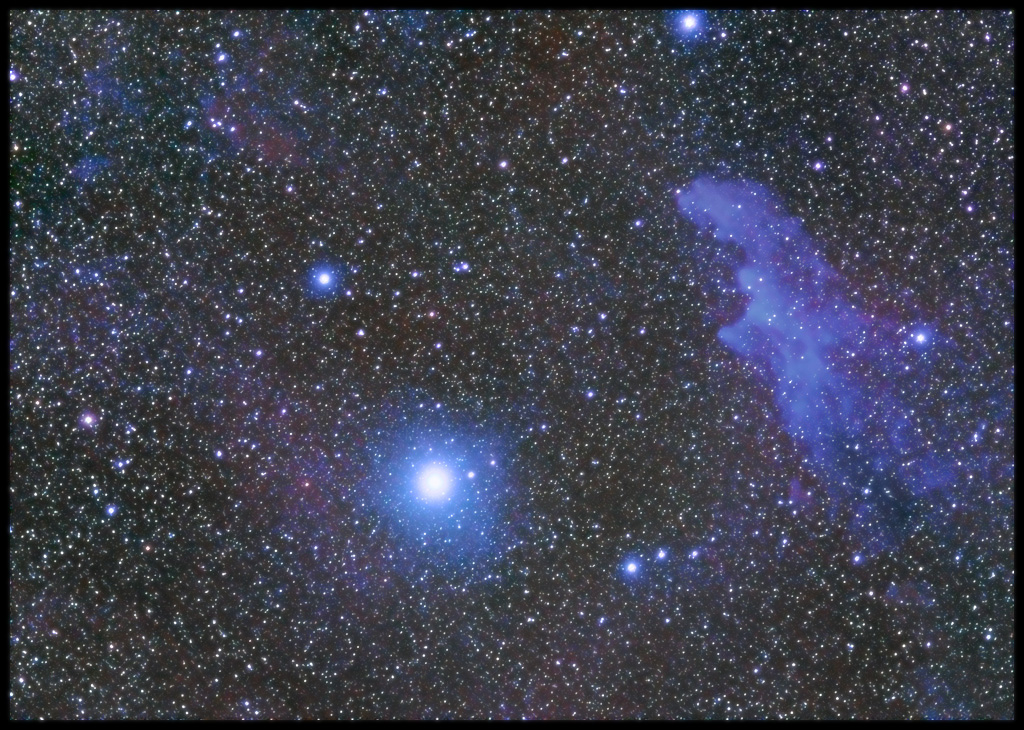Reflection Nebulae in the Winter Sky
2/13/2015. The 72 to 52mm ring works beautifully on the 180. Last night, I fitted the "stop-down" ring and enjoyed an F4 lens with greatly reduced haloes and no spikes. I took a long series of the Pleiades, 150s each, ending in the trees:

M45
47 x 150s (1:57:30 total)
180mm F2.8 with 52mm stop
Canon 6D @ ISO 1600
I focused by inspection in LiveView, just a whisker on the blue side of that point where the bright stars are at their tightest. The tracking was off in RA (!?) and the camera shifted a couple of times during the run (cord caught, strap?) so this could be better. I cropped to use only image area common to all frames which excluded some nifty dust off the upper left corner. Flats were 4 frames of my computer monitor with the camera in various orientations; the dark was a 120s master from a few weeks back; no bias frames. All in all, this was a pretty casual try. If the weather cooperates, there'll be better to come. Try the 58mm stop, should be 50% brighter and may still eliminate haloes.
Tonight, I've put the camera on the SkyTracker and left it in the cul de sac shooting the big reflection nebula west of Rigel, IC 2118, the Witch Head. I've never shot it before.

Rigel & IC 2118
45x150s (1:52:30 total)
180mm F2.8 stopped to 52mm
Canon 6D @ ISO 1600
iOptron SkyTracker
(Click the image for a bigger version.)
Astonished, I am, because the raws looked utterly hopeless. I took darks and flats immediately after this evening's exposures. IC 2118 brought some friends along: the strikingly dark region adjacent and below (real or crap on the sensor? if the latter, it should've flatted out) and suggestions of LBN 968, 975, and 980. Very faint S 278 is at upper left, about 11 o'clock from Rigel. It's a broad ruddy fan (squint --it may not come through on web renditions). I reprocessed the image, taking care to reduce noise in the integration step and that permits much more aggressive processing later on. Yowzer! A complex field of emission and reflection emerges! No surprise really since the Great Orion Nebula / M42 complex is just off the upper left edge.
2/16/2015. Though the sky be cloudy and I can't take new data, I can make better flats at leisure and use the darks I shot for the Rigel portrait to reprocess the image of the Pleiades. In an effort to better control noise, I had PixInsight integrate the subframes using a Winsorized Sigma pixel rejection scheme rather than taking a simple average. Then I further reduced noise channel by channel since the red channel was by far the noisiest. All that allowed more aggressive histogram stretching, and that, in turn, compelled me to crop more closely because more aggessive processing makes strong light pollution gradients more objectionable. There's really no substitute for longer exposures under darker skies, but in the meantime, this is entertaining:

M45 and surroundings
same data as above, but
integrated using Winsorized Sigma pixel rejection
followed by channel-by-channel noise control.
Let's wait for something better before making this big.
Except where noted, deep-sky photos are made with an SBIG ST2000XM CCD behind a 10-inch Astro-Tech Ritchey-Chretien carried on an Astro-Physics Mach1GTO. The CCD is equipped with Baader wide- and narrow-band filters. The internal guide chip of the CCD most often keeps the OTA pointed in the right direction (I'll let you know when an OAG or guidescope takes its place). Camera control and guiding are handled by Maxim DL 5.12. The stock focuser on the AT10RC has been augmented with Robofocus 3.0.9 using adapters turned on the lathe downstairs. A Canon 6D and a modded 50D find themselves mounted on an Orion 10" F4 Newtonian or carrying widefield glass on an iOptron Skytracker. Beginning in May 2013, PixInsight has taken over more and more of the heavy lifting -- alignment, stacking, gradient removal, noise-reduction, transfer function modification, color calibration, and deconvolution. Photoshop CS4 et seq and the Focus Magic plugin get their licks in, too.
:: top ::